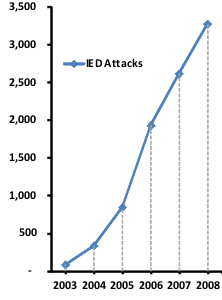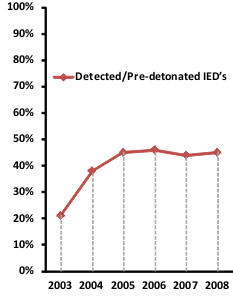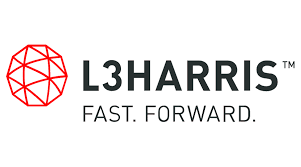Counter-IED Efforts Less Than 50% Effective
Check out our latest research on this topic: Global Homeland Security & Public Safety Market – 2014-2022
A subset of the larger war being fought between the US and the insurgents in Iraq and Afghanistan is a techno-tactical game of “cat and mouse”, and IEDs are the primary focus of this battle. As the US deploys cutting-edge counter-IED technologies and protection technologies to address the IED threat, the insurgents adjust accordingly, changing the construction and tactical objective of IEDs. And, as the data indicates, IEDs remain the single gravest challenge confronting the US, and other, militaries.
According to the DOD and NATO, since 2007, the number of IEDs in Afghanistan has jumped 350%, the number of troops killed by IEDs has increased by more than 400% and the number of wounded is up more 700%. This, despite the over $15 billion spent on counter-IED technologies and programs. Most troubling is the fact that current IED mitigation technologies and procedures are, at best, only 45% effective, which means for every two IEDs deployed, one completes its mission. As noted in a Pentagon report, “The Taliban’s Emerging IED TTPs in the Proving Grounds of Now Zad, Helmand Province,” released in August 2009: “There is an urgent need to identify new man-portable detection platforms to expand the ability of U.S. troops to detect anti-personnel IED-mines.”
 |
 |
|
|
IED attacks in Afghanistan |
|
Rate [%]of Defeated- |
In keeping with a strategy that maintains that low tech and adaptive tactics are often the best offense against a high tech equipped adversary, the Taliban are producing less-sophisticated, smaller IEDs comprised of home-made explosive materials. Additionally, according to the Pentagon and NATO, the tactical focus is shifting away from anti-armor weapons to more lethal anti-personnel bombs. The Taliban used operations in Now Zad to gauge the effectiveness of its smaller IEDs, and concluded that they inflicted much higher casualties than the previous generation. Bolstered by the results in Now Zad, the number of IED events is rising dramatically and is having a significant impact on the battlefield. Along with the fact that it is lighter, smaller and more easily concealed, this “new” generation of IED contains little or no metal components and does not employ an electronic trigger mechanism, making IEDs virtually undetectable by currently deployed counter-technologies.
Developing second–generation, counter-IED tactics and technologies is a top priority for the global defense community. The DOD (via DARPA , TSWIG and other relevant offices), NATO and other countries (e.g. Israel, India, Great Britain) have allocated significant RDT&E budgets to address this urgent issue. Technologies under development include:
- Standoff IED- wireless communication neutralization
- Standoff IED- optical communication neutralization
- IED-mines detection and/or neutralization
- Wide-area day-night surveillance
- Pre-detonation devices
HSRC forecasts that global deployment of second-generation counter-IED systems will require more than $5 billion per year.
For additional information on the efforts currently underway, HSRC has prepared a report: Global Counter IED – Markets & Technologies Forecast – 2008-2012. The research provides the most comprehensive analysis and forecasts of counter-IED markets, technologies and trends.














